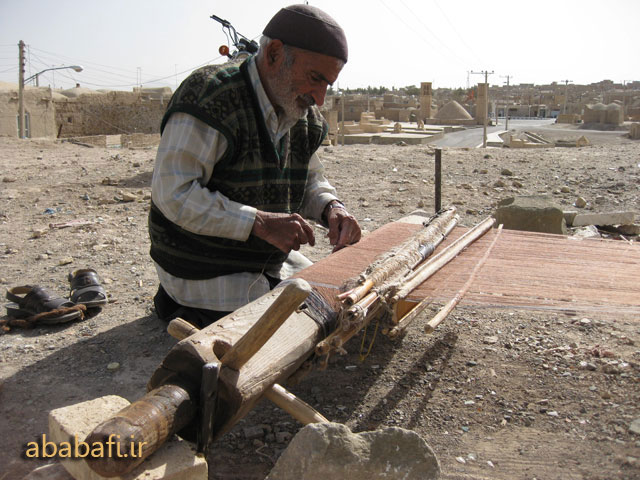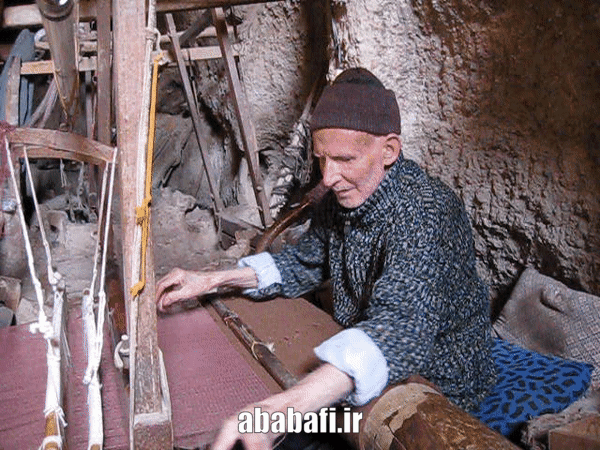
شهر نایین-shahrenaein
معرفی آثار باستانی،مکانهای دیدنی و جاذبه های گردشگری شهر تاریخی نایین
شهر نایین-shahrenaein
معرفی آثار باستانی،مکانهای دیدنی و جاذبه های گردشگری شهر تاریخی نایینNaein MohammadiehMohammadieh
Mohammadieh
Muhammadieh is a village located about 2km east of Naein. The village name means “the ones who follow the Prophet of Islam.” There are some important cultural and economic factors that cause this village to stand out among the other villages in the region: the beautiful Jameh Mosque and the Sar Kuche Mosque, the glorious fortress, the ancient Rigareh watermill, and the cloak workshops.
Hand woven carpets
Hand woven carpets
usually house wives do the carpet job
Handmade products in Naein are very important. Weaving carpets, a
fine art, began in Naein about the time of World War II. Because carpet weavers
from Naein worked with thinner wools, they began to weave rugs
of much higher quality. Since the number of carpets produced was low and the
quality of carpets was exceptionally high, the weavers found a profitable
market. Carpet-weaving in Naein has a history of applying non-Iranian wools and
of using local, traditional designs with unique coloring, thus drawing the
attention of the world market to Naein. Naein’s carpets are woven in diverse
places in Iran, thanks to the advent of technology. Weavers throughout Iran can
weave any kind of carpet. But a prospective carpet buyer should consider that
the quality of the same kind of carpet, in different places, is different. Using
natural and traditional colors and dying techniques peculiar to the region
around Naein, carpet weavers in Naein can easily profess that they are some of
the best producers of handwoven carpet in all of Iran, and the world.
worked with thinner wools, they began to weave rugs
of much higher quality. Since the number of carpets produced was low and the
quality of carpets was exceptionally high, the weavers found a profitable
market. Carpet-weaving in Naein has a history of applying non-Iranian wools and
of using local, traditional designs with unique coloring, thus drawing the
attention of the world market to Naein. Naein’s carpets are woven in diverse
places in Iran, thanks to the advent of technology. Weavers throughout Iran can
weave any kind of carpet. But a prospective carpet buyer should consider that
the quality of the same kind of carpet, in different places, is different. Using
natural and traditional colors and dying techniques peculiar to the region
around Naein, carpet weavers in Naein can easily profess that they are some of
the best producers of handwoven carpet in all of Iran, and the world.
naein carpets
Naeen carpet is woven in divers places in Iran and this is because of the
high techniques carpet weaving domination in the country, which means that the
Iranians can weave any kind of carpet. But one should consider that the quality
of carpets in divers places is different from each other. From the point of view
of coloring, Naeen carpet is one of the symbols of using natural and traditional
colors which it owes a great portion of its popularity to that. The act of
coloring or dying in this region is done by natural and traditional colors which
has a little difference with other carpet weaving centers in Iran and in spite
of some chemical colors which are use as an aid, The natural colors are still
dominant in the region.
Hand woven carpets
The number of colors which are used in weaving carpet are
11 main colors and 4 subsidiary colors.
Carpet structure relies on mixture
and traditional style which are very accurate. Some deficiencies such as
curving, not applying stamen, starching, color mixing and wrong weaving in Naeen
carpet are very little and the quality of production is very high and it has a
top standard. Weaving devices are mostly made of wood and attempts has been done
to change the wood devices in to metal devices. Naeen can easily claim that it
is one of the best producer of hand woven carpets in Iran
cloak weaving/ba bafi man made caves
Mohammadieh loom workshops in man made caves
In Muhammadieh, a precinct of Na’in, there are some man-made caves. Locals call them sardab and aba bafi. Evidence shows that they were dug by the Zoroastrian inhabitants who used to live there because the cave entrances open to the east where the sun rises. After they were abandoned by the Zoroastrians, Muslim inhabitants used them as loom workshops to weave cloaks and rugs.
There is an ancient fort over the hill, 150 m away, with a small entrance at the back. There visitors can enjoy a beautiful perspective of the village and the desert around it.
There is no fee for visiting the caves or the fort. The caves are open dawn to dusk, with a short break from noon to 13:30. Weaving cloaks by hand is one of the most valuable handicrafts and historical arts of Na’in. Some of the workshops are 700 years old.
Naein’s winter textiles are very famous and are woven from two types of sheep and camel wools. Clothing styles have changed, but the cloaks are still quite famous in some Arab countries.

cloak weaving

naein cloak weaving

The Castle of Narenj (Narenj Qal’e)
it’s the remnant of a structure that was also known as Narin castle. The construction materials used in the castle, as well as its style of architecture support the idea that it was built in the pre-Islamic era. According to surveys and evidences, this monument might belongs to Partiyan period. The exact application of the castle is not known, however it is thought to have been part of the military and official compounds of the city. Many researchers of the Safavid era have spoken of numerous castles known as Narikh Qalae, which were used for military purposes.
Hence, it can be concluded that Naeen’s Narikh Qalae was also a military establishment. The famous historian and researcher, Estakhri mentioned there was a moat with 3000 feet perimeter dug around the castle.
Mosallah edifice
 The Mosallah is another remarkable monument in Naein.
Its vast garden used to be a popular recreational area, until a few years ago.
The mausoleum inside the Mosallah was a pilgrimage site for visitors. The dome
of Mosallah is opposite the dome of the shrine of Emamzadeh Sultan Seyyed Ali.
These two are connected by a street. There is a water reservoir on one side of
the garden, which can be accessed by people inside and outside the garden
through a stairway on each side. Water in this reservoir was cooled by two wind
towers. The water reservoir–ab-anbar–was in use until a few years ago. The
architectural style of Naein’s Mosallah is characteristic of the Qajar dynasty.
A number of literary, political and religious figures are buried on this site.
Actually “mosallah” is an Arabic word for a place of prayer; but, no one knows
if any praying was ever done at this location. The Mosallah is an octagonal
mausoleum of dervishes and Qajar and Pahlavi political figures. It is
encompassed by a Qajar-era military fort with a high wall thick enough for a
horse to be ridden on. The pistachio trees around the turquoise-domed mausoleum
and two tall wind towers make the complex very photogenic. (Some photos are
attached.
The Mosallah is another remarkable monument in Naein.
Its vast garden used to be a popular recreational area, until a few years ago.
The mausoleum inside the Mosallah was a pilgrimage site for visitors. The dome
of Mosallah is opposite the dome of the shrine of Emamzadeh Sultan Seyyed Ali.
These two are connected by a street. There is a water reservoir on one side of
the garden, which can be accessed by people inside and outside the garden
through a stairway on each side. Water in this reservoir was cooled by two wind
towers. The water reservoir–ab-anbar–was in use until a few years ago. The
architectural style of Naein’s Mosallah is characteristic of the Qajar dynasty.
A number of literary, political and religious figures are buried on this site.
Actually “mosallah” is an Arabic word for a place of prayer; but, no one knows
if any praying was ever done at this location. The Mosallah is an octagonal
mausoleum of dervishes and Qajar and Pahlavi political figures. It is
encompassed by a Qajar-era military fort with a high wall thick enough for a
horse to be ridden on. The pistachio trees around the turquoise-domed mausoleum
and two tall wind towers make the complex very photogenic. (Some photos are
attached.
Mosallah edifice






